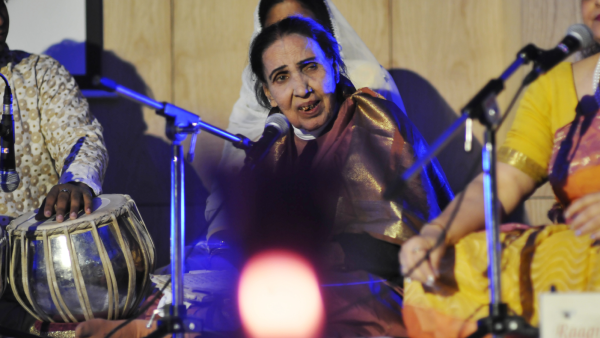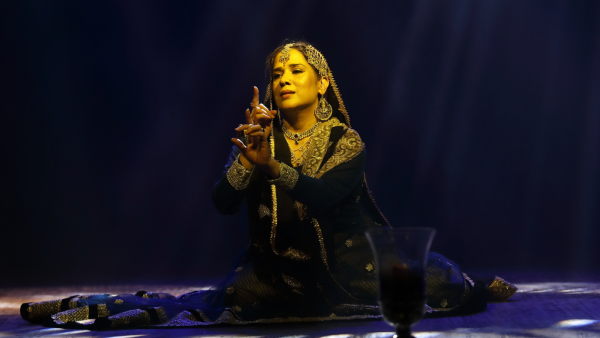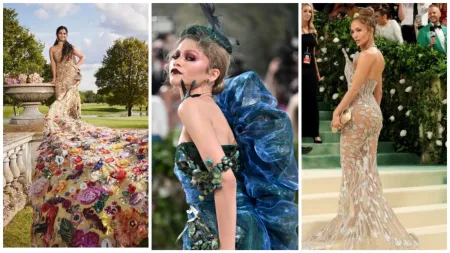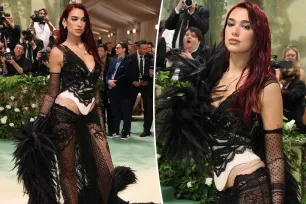Zarina Begum, a disciple of Mallika-e-Ghazal Begum Akhtar and the last singer of the Awadh courts, died in 2018 at the age of 88. Before passing away, she expressed her desire to perform in a Banarasi saree one last time, to relive the glorious days of being a courtesan (tawaif) before she breathed her last. Paralysed, battling illness, living in a dilapidated house in Lucknow and surviving on a pension, Zarina Begum owned only one Banarasi saree, an old harmonium, a tabla and handwritten Urdu lyrics at the time of her death. This was a stark difference from her life during her heydays where she lived with the Begums, ate off plates made of gold and was treated like a ‘queen’. “Humne vo sunehre din dekhe hain jo aaj khwab maloom hote. Woh Begumon ki tarah ka rehen-sehen, heere- zavaharat, rupaiya-paisa, aishon-aaram, Zarina ke paas sab kuch tha (I have seen the golden days that seem like a dream today. The lifestyle of an empress, money, luxury, Zarina had everything),” she had reminisciced in an interview with Hindustan Times then.
Zarina’s life of obscure poverty, during her final days, contrasted with what we’ve witnessed recently in Sanjay Leela Bhansali’s much-anticipated Netflix series Heeramandi: The Diamond Bazaar. Far removed from the palatial havelis, ornate and intricate outfits and jewellery portrayed in the series, Zarina had a rather difficult life as tawaifs were no longer accorded the ‘izzat (respect)’ they deserved as the Britishers colonised India and brought their Victorian era beliefs with them.

Before that, there existed a time when tawaifs were pillars of art, culture, and aesthetics in India’s rich history. These women, known for their intellect, artistic prowess, and influence, commanded respect within the elite circles of society. However, the tides turned drastically with the onset of the British Raj, as colonial rule began reshaping societal norms and marginalising tawaifs in the process.
The male gaze in art forms
During this period, the British authorities and missionaries stigmatized the tawaifs, reducing their complex and refined art forms to mere entertainment. Their diverse talents in music, dance, literature, and poetry were diminished, and the tawaifs were eventually labelled as “nautch girls” or dancers, a far cry from the revered position they once held in society. Acclaimed Sufi-Kathak exponent Manjari Chaturvedi, who has relentlessly been working to breathe new life into the long-forgotten world of tawaifs and their rich cultural heritage, tells Indianexpress.com, “Male performers were called ustaads, but the females were not given the same respect and were called naachnewali. Art should be judged for its art, not gender. Why should these terminologies still exist? And why should art be seen through the lens of gender? Whether she is a woman performer or a male performer, they should be equal. We have to see if the raag is right, the taal is right, the tukda is right. When a man is performing this raag, he is considered good, but when a woman is performing the same raag, toh woh naachnewali hai.”
 Zarina Begum at her last performance.
Zarina Begum at her last performance.
Through The Courtesan Project, an initiative Chaturvedi launched in 2011, she aims to shatter social stigmas and restore the rightful place of courtesans as respected artistes in society. Chaturvedi’s ‘Main Tawaif’ a presentation under The Courtesan Project Series, is a profound exploration of the gender dynamics within the arts, unveiling the pivotal influence of women performers – the enigmatic tawaifs and baijis – of North India from the 16th to the 20th century.
So who were the tawaifs or the courtesans really and why were they revered? Answers Chaturvedi, “When we talk about the tawaif culture, we instantly associate it with the Mughals. However, when we go back in history, there was Amarapali from Buddha’s period, who subsequently became a Buddhist. She was the nagar wadhu or the courtesan of that period. So, history has had courtesans as part of the Indian tradition, way before the Mughal period. It can be traced back to the myths where Lord Indra’s court had Rambha and Meneka, also called the apsaras. They were the ones who sang and danced and were sent to disrupt sages’ tapasya. Courtesans were associated with art forms such as singing and dancing in ancient India and there is evidence in Indian mythology. The courtesan culture is very much a part of our narrative.”
Tawaif and mujra, not bad words
Two decades ago, Chaturvedi’s path crossed with Zarina, the ‘last tawaif, marking a pivotal moment in her life. She first came face-to-face with the tawaif tradition upon meeting Zarina, an embodiment of both tawaif and Mirasin singing styles. Zarina had reached out to the Sufi Kathak Foundation, seeking a pension in her old age. Overwhelmed by Zarina’s dire circumstances, Chaturvedi witnessed the once-celebrated artiste confined to a single-room dwelling, her days spent seated by a lone window. “She was paralyzed, and we decided to help her,” recalls Chaturvedi. Filled with empathy, she asked Zarina how she could be of assistance. The latter’s heartfelt reply was, “Beti, all I want to do is wear a Banarasi saree and be on stage once again. We decided to help her fulfil their dream,” she tells us. However, raising funds for the show proved challenging, as many were reluctant to be associated with a ‘prostitute’.
 Manjari Chaturvedi launched The Courtesan Project in 2011
Manjari Chaturvedi launched The Courtesan Project in 2011
Chaturvedi’s impassioned plea to embrace the term ‘tawaif’ underscores her dedication to dismantling the shame and stigma associated with these artistes. She argues, “Today, terms like tawaif and mujrawali are considered derogatory. I urge people to use these terms but with respect. These words and these women may be looked down upon but it wasn’t the case back in the day. They were revered as dancers, singers, and performers.”
Chaturvedi hopes to shed light on the invaluable contributions of tawaifs in preserving various art forms, such as ghazals, Kathak, dadra, chhota khayal, and thumri, for centuries. “We need to respect the women performers who performed various art forms and kept them alive for a good 300-400 years,” says Chaturvedi, adding, “They were regular women who loved and lost. They were, at times, shunned by people. They were sometimes rich, sometimes poor but the most important thing about them is that they kept their art intact, preserved them and passed on their art in the best possible manner.”
Celebrated artistes, misunderstood women
In one of the scenes of Heeramandi, Manisha Koirala’s character, Mallikajaan, when presented in the court, says, “Jise aap tawaif kehte hain woh fankaar hai. Hum logon ki mehfilen sajate hain aur log humein tamashabaaz kehte hain (You call us tawaif, we are artistes. We perform art forms and you reduce us to mere entertainers).”
Tawaifs have been an integral part of Indian culture for centuries. They were highly skilled poets, artistes, dancers, and entertainers who catered to the nobility. However, their journey has been marred by misconceptions, stereotypes, and a gradual decline in their status and opportunities. In the early days, tawaifs enjoyed a revered position in society. They were highly educated and well-versed in poetry, music, and dance. Their elegance and sophistication made them sought-after companions for the elite, and they were respected for their artistry. Many tawaifs even held influential positions in royal courts, such as Mah Laqa Bai, a renowned poet and courtesan during the 18th century.
“Amrapali was a singer and dancer in the North and Devdasis in the South. They were trained musicians and dancers who influenced art and culture. If you look at the old paintings of Raja Ravi Varma, you can see women musicians and dancers. Our ancient miniature paintings depict women holding musical instruments and in dance poses. You cannot take the art away from them. In India, music and dance are major expertise and not something superficial. They require in-depth knowledge. They had delved into the intricate dance forms and music and spent years training themselves and perfecting them. We cannot consider them as shallow or women of sex as the look perceives them,” she adds.
The decline of the rich tradition
The arrival of the British Raj brought about a shift in the perception of tawaifs. The stigmatisation had a profound impact on the lives of tawaifs, as they were gradually pushed to the margins of society and their artistry was overshadowed by their perceived immorality. “British colonial officials failed to understand the nuanced role of courtesans in Indian society and labelled them as ‘nauch girls’ and they treated all the singers and dancers as prostitutes. There were various kinds of performers such as behrupiya, nakkas etc and tawaif were the high form of performers who were not accessible to all. Not everyone could afford to see their performance, but the British failed to understand that. Unfortunately, post Independence, nobody aimed at correcting it,” adds Chaturvedi, continuing, “As of now, there are no tawaifs or courtesans in India anymore. Post 1857, there was a downfall as there were no longer the kings or nawabs, the patrons of the tawaifs. Art needs patronage and unfortunately, there is no patronage from either the government or the corporates. She laments that nobody attempted to resurrect them and tried to revive their art. While many perished while some managed to survive with the help of Parsi theatre and Hindi cinema. “They died in penury,” she rues.
Tawaifs through the lens of Indian filmmakers
 Meena Kumari in Pakeezah. (Express archive photo)
Meena Kumari in Pakeezah. (Express archive photo)
Indian cinema has had a long and complex relationship with tawaifs. Over the years, the portrayal of these skilled artistes has evolved, reflecting changing societal attitudes and shedding light on their multifaceted lives.
In the early days of Indian cinema, tawaifs were often depicted as tragic figures, torn between their artistic aspirations and the expectations of society. Films such as Devdas (1955) and Pakeezah (1972) showcased the beauty and elegance of tawaifs but also highlighted the stigma and struggles they faced. As cinema progressed, filmmakers began exploring more nuanced aspects of tawaifs and their role in society. The 1981 film Umrao Jaan, for instance, depicted the life of a famed courtesan, showcasing her artistic prowess and emotional depth.
The 1990s saw a decline in tawaif-centered films, but recent years have witnessed a renewed interest in these complex characters. Movies such as Dedh Ishqiya (2014) and Begum Jaan (2017) and Heeramandi: The Diamond Bazaar sought to subvert stereotypes by portraying courtesans as strong, independent women who are in control of their lives and choices. However, Chaturvedi asserts that one must not treat Bollywood and its portrayal of tawaifs as lessons from history because filmmakers making these film only want to sell tickets and tell a narrative which will help bring audiences to the theatres. “Why are we giving Bollywood the responsibility of teaching us history? It is not their job,” asserts, Chaturvedi, adding, “Pakeezah and Umrao Jaan were perhaps the only realistic films which depicted the tawaifs as artistes. There were songs and dance and in fact, Pakeezah features songs like “Thare Rahiyo O Banke Yaar Re” is actually a dadra of the tawaif of Banaras. “Inhi logo ne le lina dupatta mera” which was a song sung at most of the kothas at that time. The elements of existing tawaifs were very well used in Pakeezah and who makes a film for 10 years in today’s world! Nobody does it when the filmmakers have a lot of money riding on films.”
 Rekha in Umrao Jaan. (Express archive photo)
Rekha in Umrao Jaan. (Express archive photo)
The artiste adds that unlike Muzaffar Ali, the director of Umrao Jaan, who had real-life historical references of tawaifs, today’s filmmakers won’t have. “They may say whatever they want, but there are no tawaifs today so they don’t have any historical reference to use in their films,” she adds. Till the 1980s, films depicted tawaifs performing sleazy and titillating dance numbers. “They were glamourised and people perceived them as women who only wanted to look pretty. And that is where Bollywood has gone wrong, they were real women, who looked pretty when they performed but otherwise were ordinary women in their real lives. They projected a tawaif to suit their narrative. If they wanted to make her look like a bechari, they would make a look like a bechari. If their story required a vamp, or gunda or a strong woman they make her look like one,” Chaturvedi adds.
Speaking of Sanjay Leela Bhansali’s Heeramandi, she comments, “Sanjay Leela Bhansali is a brilliant filmmaker, he’ll obviously make a brilliant series but he is not teaching you history about tawaifs and even if he is claiming to teach you history, he shouldn’t make such claims as his medium doesn’t showcase history. He will show the women in the manner in which people would like to see. If people would like to see these women as glamorous then he would would showcase them as glamorous women. Bollywood tweak their stories to suit themselves. For example, a Jaddanbai who had only one husband and children but was a brilliant performer, nobody would make a story on her because there’s no spice or masala in her life. She was an incredible artiste but I’m sorry, why would Bollywood be interested in her? She was woman who was a brilliant artist, married only once, had no affairs, sang beautifully, trained her children but she’s not interesting enough for Bollywood.”
Click for more updates and latest Bollywood news along with Entertainment updates. Also get latest news and top headlines from India and around the world at The Indian Express.
Disclaimer: The copyright of this article belongs to the original author. Reposting this article is solely for the purpose of information dissemination and does not constitute any investment advice. If there is any infringement, please contact us immediately. We will make corrections or deletions as necessary. Thank you.







